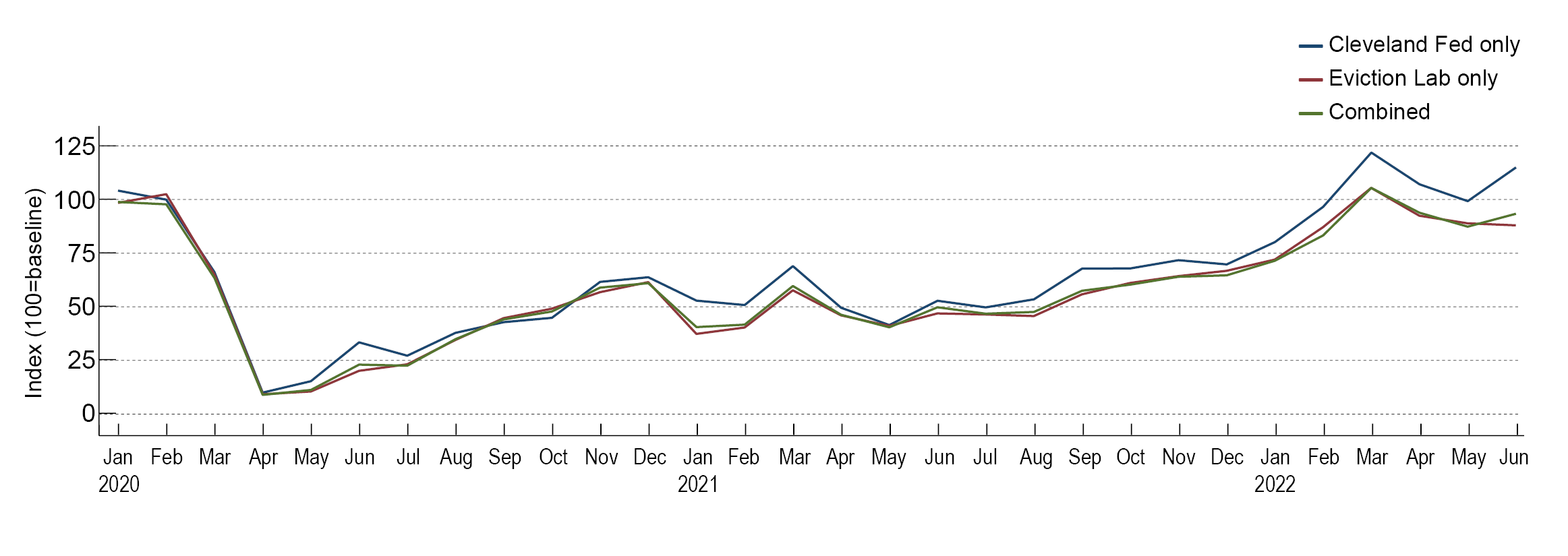At the outset of the COVID-19 pandemic, the economic vulnerability of renters quickly came into focus. Unemployment for them rose higher than for homeowners. Renters also were not prioritized in some of the efforts to protect housing stability during the early stages of the public health crisis.
What we didn’t know about risks to renters
Would renters be subject to a wave of evictions? What sort of public policy response would keep that from happening? Frustratingly, there was no way to tell with certainty if evictions would increase or not. My colleagues and I set out to change that, and we produced some of the first broad-based measures of eviction trends in the early days of the pandemic. Other researchers added to our knowledge, and we began to get a clearer picture of what was happening, at least with formal eviction filings in court systems.
Lessons learned from the data
We quickly learned that filings were not trending up, contrary to what some commentators predicted. In fact, early in the pandemic, eviction filings fell dramatically across the country. This decline coincided with strong but temporary local policy measures restricting eviction filings and proceedings that have since expired. These temporary local measures were followed by federal policy restricting evictions and, in 2021, with substantial emergency rental assistance funding.
But 2021 also brought a sharp increase in rent price growth, which had flattened or declined in many places when the pandemic began. It is perhaps no coincidence that eviction filings have now returned to roughly pre-pandemic levels (Figure 1).
Figure 1: Monthly eviction filings
January 2020–June 2022

Sources: Federal Reserve Bank of Cleveland, Eviction Lab, author’s calculations
Note: Eviction filings are reported relative to the same month in a baseline period. The baseline period is 2019 for Cleveland-tracked jurisdictions and is a range of recent years for Eviction Lab-tracked jurisdictions. Graph reflects the average eviction filing index across the sample of jurisdictions and is weighted by rental market size.
When I examined the trends in local market conditions, policies enacted to protect renters, and local eviction filings from January 2020 through June 2022, I found some interesting correlations.
Filing restrictions appear to be effective
Local policies that restricted eviction filings and proceedings were very common at the start of the pandemic, but were gradually allowed to lapse. There was a clear relationship between such filing restrictions and the filing of evictions. This relationship may seem obvious, but restrictions on filings were usually not comprehensive; for instance, filings unrelated to non-payment of rent were often still permitted. Even so, in places with such filing restrictions, filings were 62 percent lower than in locales without any such restrictions.
Emergency rental assistance depressed eviction filings in the short-term
The rollout of $47 billion in emergency rental assistance was slow after the programs were authorized by Congress in December of 2020 and March of 2021. Some places did not begin disbursements for months, leaving renters and landlords waiting for help as rent debts accrued. I found a correlation between the timing of rental assistance and eviction filings. Most of these programs require landlords to agree not to evict tenants for a window of time after they receive emergency rental assistance. That window of protection varies by locality, so I looked at how disbursements of rental assistance in the current and prior two months affect the current month’s eviction filing trend. Relative to pre-pandemic times, I noticed a 17 percent decline in eviction filings for every 1 percent of rental households receiving assistance in the current or prior two months. The reprieve doesn’t last, though – there is some evidence that evictions tick up again after that window of protection closed.
With rising rent comes rising eviction risk
Rent prices fell in some markets and rose slowly in others as the pandemic got underway. All of that changed in 2021, when rent prices began to rise sharply in many markets. My research shows a clear relationship between recent increases in rents and eviction filing trends. For every 1 percent increase in rent over the prior three months a market experienced a 2 percent increase in eviction filings compared to prior years. This might be because landlords in tighter rental markets have an easier time finding paying tenants and are less inclined to wait for non-paying tenants to catch up. Or perhaps landlords can afford to raise rents in such markets and existing tenants are unable to keep up with the increases.
What comes next?
There is still a lot that drives trends in evictions that these data do not explain. To that end, the pandemic has been a catalyst for research efforts giving rise to the development of new tracking tools that give us better real-time measures of eviction filing trends.
These tools will be important in helping us understand the impact of major policy changes affecting renters and landlords. Many localities have enacted new programs and policies aimed at helping renters stay housed, including eviction diversion programs, right-to-counsel and pay-to-stay laws.
Eviction diversion programs encourage mediation between landlords and tenants while directing them to use available assistance programs to work out rent debts. Right-to-counsel laws provide tenants with representation by an attorney in eviction hearings. Pay-to-stay laws require that tenants not be evicted if they catch up on their rent debt before their eviction case passes certain milestones.
Researchers and policymakers will be watching these relatively new programs and policies to understand how well they serve tenants, landlords, and the stability of the rental market going forward.
Last October, I discussed some of these new policies with experts. You can watch that session below. This October, I’ll be holding another discussion to share what we’ve learned in the last year. I hope you’ll join me.







